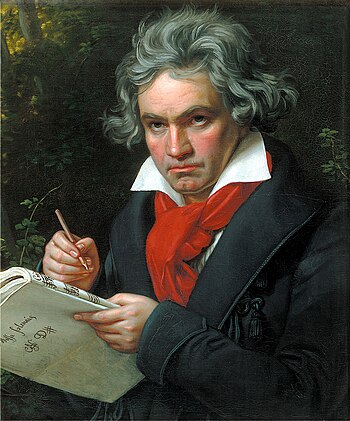ROMANTIC ERA
Prior to the Romantic Era, classical music was like an artist learning techniques. First, like an artist learning the basics of drawing and painting and the simplest tools of creation to make great works, during the Middle Ages, Renaissance, and Baroque, classical music developed the basic language of musical creation. During the Classical Era, techniques have been perfected, like a student artist who can now create the most beautiful of still life paintings realistically, but lacks inspiration.
The Romantic Era, to me, seems to be the musical period where classical music has reached maturity, true maturity. This would be when the artist has perfected his or her craft, has truly grasped inspiration, and can create amazing masterpieces full of passion and life.
The 20th century reminds me of the mature artist who has tired of perfection and creating what others have expected. Now the artist wants to explore, to go wild, to travel into new avenues yet created. The artist wants to be remembered for all time for cutting edge creations, or just forgotten altogether. Everything known before has been thrown to the wayside, and the artist doesn't care about pleasing the public. In the same way, during the 20th century, composers decided to ignore and abandon traditional western classical music. They added music from other cultures, abolished tonality and harmony, and created works that challenged the very idea of music.
 Many composers of the Romantic era (and even earlier eras) enjoyed adding bits of musical culture from other societies. For example, the Nutcracker Suite by Tchaikovsky (a well known Romantic era ballet composer) borrowed heavily from music from the Middle East, China, and Russia. The composer Dvorak, after visiting the US for a year, created the New World Symphony, using music like the blues and Native American music that he heard during his visit. Debussy, an early 20th century composer, also incorporated music from the East in his music. Works like "La Mar" incorporated unique chordal sounds that were uncommon in Western tonal harmony, like the whole tone scale.
Many composers of the Romantic era (and even earlier eras) enjoyed adding bits of musical culture from other societies. For example, the Nutcracker Suite by Tchaikovsky (a well known Romantic era ballet composer) borrowed heavily from music from the Middle East, China, and Russia. The composer Dvorak, after visiting the US for a year, created the New World Symphony, using music like the blues and Native American music that he heard during his visit. Debussy, an early 20th century composer, also incorporated music from the East in his music. Works like "La Mar" incorporated unique chordal sounds that were uncommon in Western tonal harmony, like the whole tone scale.
Prior to the Romantic Era, classical music was like an artist learning techniques. First, like an artist learning the basics of drawing and painting and the simplest tools of creation to make great works, during the Middle Ages, Renaissance, and Baroque, classical music developed the basic language of musical creation. During the Classical Era, techniques have been perfected, like a student artist who can now create the most beautiful of still life paintings realistically, but lacks inspiration.
The Romantic Era, to me, seems to be the musical period where classical music has reached maturity, true maturity. This would be when the artist has perfected his or her craft, has truly grasped inspiration, and can create amazing masterpieces full of passion and life.
The 20th century reminds me of the mature artist who has tired of perfection and creating what others have expected. Now the artist wants to explore, to go wild, to travel into new avenues yet created. The artist wants to be remembered for all time for cutting edge creations, or just forgotten altogether. Everything known before has been thrown to the wayside, and the artist doesn't care about pleasing the public. In the same way, during the 20th century, composers decided to ignore and abandon traditional western classical music. They added music from other cultures, abolished tonality and harmony, and created works that challenged the very idea of music.
Nationalism and "Exotic Music"
 Many composers of the Romantic era (and even earlier eras) enjoyed adding bits of musical culture from other societies. For example, the Nutcracker Suite by Tchaikovsky (a well known Romantic era ballet composer) borrowed heavily from music from the Middle East, China, and Russia. The composer Dvorak, after visiting the US for a year, created the New World Symphony, using music like the blues and Native American music that he heard during his visit. Debussy, an early 20th century composer, also incorporated music from the East in his music. Works like "La Mar" incorporated unique chordal sounds that were uncommon in Western tonal harmony, like the whole tone scale.
Many composers of the Romantic era (and even earlier eras) enjoyed adding bits of musical culture from other societies. For example, the Nutcracker Suite by Tchaikovsky (a well known Romantic era ballet composer) borrowed heavily from music from the Middle East, China, and Russia. The composer Dvorak, after visiting the US for a year, created the New World Symphony, using music like the blues and Native American music that he heard during his visit. Debussy, an early 20th century composer, also incorporated music from the East in his music. Works like "La Mar" incorporated unique chordal sounds that were uncommon in Western tonal harmony, like the whole tone scale.BRAHMS and SCHUMANN
Brahms was quite an impressive pianist by the time he had reached early adulthood, earning the "musical messiah" from composer Robert Schumann (creator of the famous work "Carnival"), which he attempted to fulfill. His fateful meeting with the Schumann family gave birth to a lifelong forbidden love for Robert Schumann's wife, composer and pianist Clara. Some musicologists surmise that Brahms, who never married, dedicated many of his works to Clara, who inspired him musically and personally. Clara and Robert had an intense love between them, often writing compositions in celebration of their romance. Unfortunately, his mental illness eventually caused an eternal separation, paving the way for the young student Brahms. Much of the story between Clara and Brahms is conjecture, since the couple destroyed the letters written between them. Like every composer before or after him, Chopin's relationships played a vital role in his music throughout his life.
Brahms was quite an impressive pianist by the time he had reached early adulthood, earning the "musical messiah" from composer Robert Schumann (creator of the famous work "Carnival"), which he attempted to fulfill. His fateful meeting with the Schumann family gave birth to a lifelong forbidden love affair with Robert Schumann's wife, composer and pianist Clara. Some musicologists surmise that Brahms, who never married, dedicated many of his works to Clara, who inspired him musically and personally.
Brahms was quite an impressive pianist by the time he had reached early adulthood, earning the "musical messiah" from composer Robert Schumann (creator of the famous work "Carnival"), which he attempted to fulfill. His fateful meeting with the Schumann family gave birth to a lifelong forbidden love affair with Robert Schumann's wife, composer and pianist Clara. Some musicologists surmise that Brahms, who never married, dedicated many of his works to Clara, who inspired him musically and personally.
WAGNER AND THE LEITMOTIF
Wagner's music and concept of the leitmotif actually gave birth to many compositional ideas that film composers use today. The Leitmotif essentially was a musical idea that appeared specific to one character. In other words, the hero would have one musical idea, the heroine another. Film composers still use this idea today. Wagner was also well known for his extreme nationalism. Wagner's concept of the leitmotif has translated well into modern film composition. In fact, every film composer knows that he or she must devise a theme (or leitmotif) for the protagonist and antagonist of the film. This musical cue gives the audience an aural "heads up" that a specific character is about to enter the scene or plays an important part.
For example, in the movie Jaws, John Williams assigns a particular motif based on minor seconds to the shark. Every time one hears this motif, the audience knows that the shark is out there, somewhere. Stephen Spielberg and John Williams (as well as Tim Burton and Danny Elfman) have a very unique director/composer relationship. Unlike many film directors, who create a film and then give the composer a couple of months to devise a film score, Spielberg has often created films with William's music in mind.
An excellent film example of a leitmotif is John William's melody for the movie Close Encounters of the Third Kind. Here, the simple five note melody has been integrated into the entire film, from beginning to end. It is part of the regular score as well as becoming a way for the aliens to communicate with the earthlings. That simple five note melody (like Wagner's leitmotif) represents the aliens throughout the film.
For example, in the movie Jaws, John Williams assigns a particular motif based on minor seconds to the shark. Every time one hears this motif, the audience knows that the shark is out there, somewhere. Stephen Spielberg and John Williams (as well as Tim Burton and Danny Elfman) have a very unique director/composer relationship. Unlike many film directors, who create a film and then give the composer a couple of months to devise a film score, Spielberg has often created films with William's music in mind.
An excellent film example of a leitmotif is John William's melody for the movie Close Encounters of the Third Kind. Here, the simple five note melody has been integrated into the entire film, from beginning to end. It is part of the regular score as well as becoming a way for the aliens to communicate with the earthlings. That simple five note melody (like Wagner's leitmotif) represents the aliens throughout the film.
LISZT
You might consider Franz Liszt the Lady Gaga of his time. He had a striking face, charmed his audiences, and always seemed on the brink of controversy. For example, Franz Liszt caused a huge stir when he decided that he would perform the piano in profile (before that, the pianist would have their backs facing the audience). Such a thing had never been done before. What a scandal! Liszt enjoyed the attention (especially of the ladies), and felt playing the piano in profile emphasized his handsome features. If Liszt lived today, he would probably love the attention of the paparazzi and be in the tabloids every single day.
Liszt also had reportedly extremely long fingers. Most pianists can easily spread their fingers to play an octave, and possibly slightly further. Liszt could easily play a thirteenth, which was well over a foot long! Just take your right hand and try to spread out your fingers as far as possible. Measure the length. Now imagine having to forcefully hit piano keys in time musically with your fingers spread over a foot! Ouch! (My sister, who is a pianist, has always hated doing Liszt's works. While she loves the music, her own feminine hand has to practically dislocate her fingers in order to perform. Good thing her fingers are double-jointed!)
Liszt also had reportedly extremely long fingers. Most pianists can easily spread their fingers to play an octave, and possibly slightly further. Liszt could easily play a thirteenth, which was well over a foot long! Just take your right hand and try to spread out your fingers as far as possible. Measure the length. Now imagine having to forcefully hit piano keys in time musically with your fingers spread over a foot! Ouch! (My sister, who is a pianist, has always hated doing Liszt's works. While she loves the music, her own feminine hand has to practically dislocate her fingers in order to perform. Good thing her fingers are double-jointed!)



